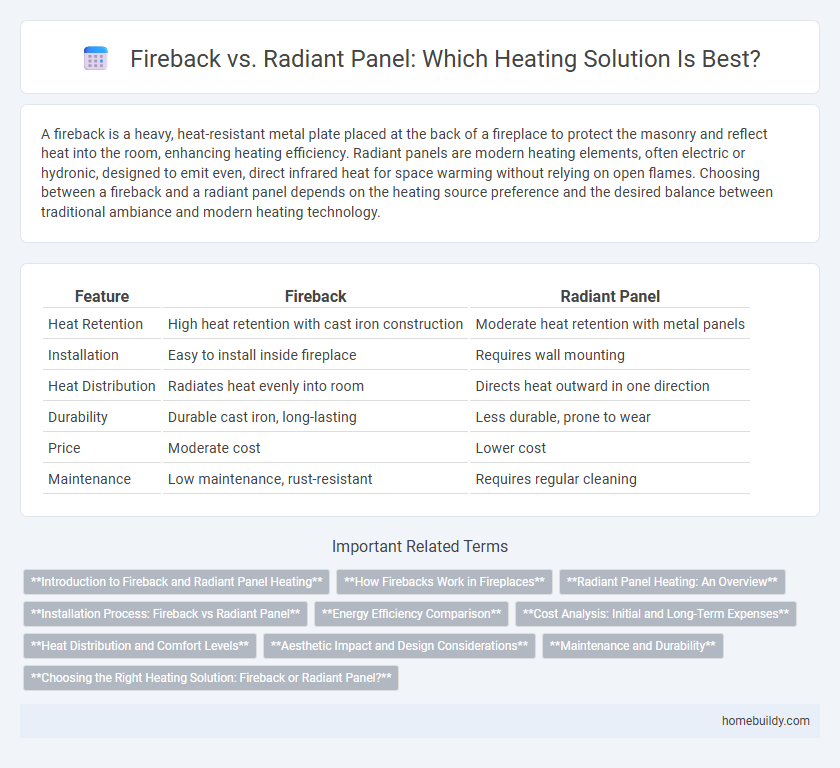A fireback is a heavy, heat-resistant metal plate placed at the back of a fireplace to protect the masonry and reflect heat into the room, enhancing heating efficiency. Radiant panels are modern heating elements, often electric or hydronic, designed to emit even, direct infrared heat for space warming without relying on open flames. Choosing between a fireback and a radiant panel depends on the heating source preference and the desired balance between traditional ambiance and modern heating technology.
Table of Comparison
| Feature | Fireback | Radiant Panel |
|---|---|---|
| Heat Retention | High heat retention with cast iron construction | Moderate heat retention with metal panels |
| Installation | Easy to install inside fireplace | Requires wall mounting |
| Heat Distribution | Radiates heat evenly into room | Directs heat outward in one direction |
| Durability | Durable cast iron, long-lasting | Less durable, prone to wear |
| Price | Moderate cost | Lower cost |
| Maintenance | Low maintenance, rust-resistant | Requires regular cleaning |
Introduction to Fireback and Radiant Panel Heating
Firebacks are cast iron plates installed behind wood-burning fireplaces to absorb and radiate heat, improving efficiency and protecting the masonry. Radiant panels, typically electric or hydronic, emit infrared heat directly to objects and occupants, offering uniform warmth without requiring combustion. Both systems enhance heating performance, but firebacks rely on thermal mass, while radiant panels provide immediate, controlled heat distribution.
How Firebacks Work in Fireplaces
Firebacks are typically made of cast iron or steel and positioned against the rear wall of a fireplace to absorb and radiate heat back into the room, enhancing the efficiency of the fire. Unlike radiant panels, which primarily serve as heat reflectors attached to the fireplace opening, firebacks directly protect the masonry from intense heat while improving overall heat distribution. The dense metal construction of firebacks stores thermal energy during combustion and slowly releases it, increasing warmth and reducing heat loss through the chimney.
Radiant Panel Heating: An Overview
Radiant panel heating delivers consistent, efficient warmth by radiating heat directly to objects and occupants, minimizing energy loss compared to traditional convection methods. Unlike firebacks, which absorb and radiate heat from a fireplace, radiant panels can be installed in walls or ceilings, providing more versatile and evenly distributed heat throughout a space. Their low surface temperature and silent operation make radiant panels an ideal choice for modern, energy-conscious heating solutions.
Installation Process: Fireback vs Radiant Panel
Firebacks are typically installed directly against the masonry of a fireplace, requiring precise alignment and often professional assistance due to their weight and need for heat-resistant adhesives or mortar. Radiant panels offer a more straightforward installation, usually mounted on the wall behind the fire, secured with brackets or screws, and compatible with various fireplace types. This difference makes radiant panels more accessible for DIY installation, while firebacks provide enhanced durability but demand careful handling during setup.
Energy Efficiency Comparison
Firebacks provide superior energy retention by absorbing and radiating heat longer after the fire has died, resulting in enhanced room warmth and reduced fuel consumption. Radiant panels primarily emit heat directly from the fire, offering immediate warmth but less efficient heat storage and distribution. Consequently, firebacks contribute to greater overall energy efficiency in wood-burning fireplaces compared to radiant panels.
Cost Analysis: Initial and Long-Term Expenses
Firebacks typically have a lower initial cost compared to radiant panels, making them a budget-friendly choice for enhancing fireplace efficiency. Long-term expenses for firebacks may include occasional maintenance such as cleaning and possible replacement due to cracking, whereas radiant panels, although initially more expensive, generally require less frequent upkeep and offer enhanced heat distribution. Evaluating total cost of ownership involves considering both upfront investment and durability factors tailored to specific heating needs.
Heat Distribution and Comfort Levels
Firebacks provide superior heat distribution by absorbing and radiating warmth evenly across a room, creating a consistent and comfortable environment. Radiant panels produce instant heat but tend to create hotspots with less uniform warmth, leading to fluctuating comfort levels. The thermal mass of firebacks ensures prolonged heat release, enhancing overall coziness and energy efficiency.
Aesthetic Impact and Design Considerations
Firebacks offer a classic, decorative touch to fireplaces, often crafted from cast iron and featuring intricate designs that enhance the visual appeal of traditional hearths. In contrast, radiant panels provide a sleek, minimalist appearance, blending seamlessly into modern interiors without drawing attention. The choice between firebacks and radiant panels hinges on the desired aesthetic impact, with firebacks emphasizing ornamental character and radiant panels prioritizing subtle design integration.
Maintenance and Durability
Firebacks offer superior durability compared to radiant panels, as they are typically made from heavy cast iron or steel that withstands high temperatures and physical impact without warping or cracking. Maintenance for firebacks is minimal, often requiring only occasional cleaning to remove soot and ash, whereas radiant panels may need more frequent inspection and servicing to maintain optimal heat output. Firebacks' robust construction ensures long-term performance and reduces the risk of damage, making them a reliable choice for enhancing fireplace longevity.
Choosing the Right Heating Solution: Fireback or Radiant Panel?
Firebacks offer efficient heat retention and radiate warmth evenly through cast iron, ideal for traditional fireplaces seeking enhanced heat output and aesthetic appeal. Radiant panels provide instant, directed infrared heat, making them perfect for modern spaces requiring quick, energy-efficient warmth with minimal installation. Selecting between a fireback and a radiant panel depends on factors such as fireplace type, heating needs, installation preferences, and desired ambiance.
Fireback vs Radiant Panel Infographic

 homebuildy.com
homebuildy.com